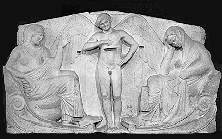Because of its low relief, it has been suggested that the Ludovisi Throne was meant to be seen outside in strong sunlight. Alternatively, although there is no scientific evidence for the use of paint, it is not impossible to think that the low relief was painted, as were some contemporary works of art. This would explain the absence of small details, such as the lack of straps on the priestess' sandals. The Ludovisi Throne could therefore have functioned just as well indoors as outdoors.
The Ludovisi Throne was probably taken to Rome as booty by the armies of the Roman Empire and used to adorn the areas of the Ancient Gardens of Sallust. |
| Due to the similar design and dimensions of the two thrones, it would seem that the Boston Throne, below, was designed to go with the Ludovisi. This was perhaps for merely decorative reasons, or to fulfill a religious function. |
 |
The two could easily be accounted as functioning together as: |
| As in the case of the suggested origins of the Boston Throne, the above theories could all be possible, but it seems most likely that the Ludovisi Throne was used on its own in the temple of Aphrodite at Locri. |